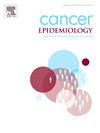The effects of area-level deprivation on colorectal cancer incidence at the small area-level in Pennsylvania from 2008 to 2017
IF 2.3
3区 医学
Q3 ONCOLOGY
引用次数: 0
Abstract
Background
Colorectal cancer (CRC) is the third most diagnosed cancer in the United States. Area-level deprivation increases CRC risk, but traditional indices and analyses have limitations. Weighted Quantile Sum (WQS) regression and hierarchical Bayesian approaches offer better alternatives for highly correlated indicators and addresses spatial dependencies and reliability issues. The purpose of this study is to identify the most explanatory area-level neighborhood deprivation indicators and investigate its association with CRC incidence using advanced spatiotemporal methods.
Methods
Analyzing 34,250 CRC cases from Pennsylvania between 2008 and 2017, we constructed an area-level neighborhood deprivation index using WQS from 39 block group and census tract level demographic, social, economic, and housing indicators from the US Census Bureau’s American Community Survey five-year pooled estimates. Census tract was used when block group data was unavailable. Spatiotemporal modeling, using hierarchical Bayesian methods, assessed the effect of age, sex, area-level neighborhood deprivation, healthcare access, CRC screening, and rurality on the risk of block-group level CRC incidence.
Results
For the neighborhood deprivation index, we identified nine statistically-significant area-level economic, demographic, and housing-related variables (p < 0.05). Of these, the total count of housing units, median household income, and proportion of the population ages 25 years of older not graduating high school contributed 61 % of the total weight of the index. Area-level neighborhood deprivation significantly predicted CRC risk, with a 1.33-fold increase in incidence for each one-unit increase of the index, adjusted for block group age- and sex-distribution. Access to healthcare, CRCS adherence, and rurality were not significantly associated with the incidence of colorectal cancer.
Conclusion
A WQS-developed area-level neighborhood deprivation index may be useful in identifying small geographic areas at highest risk of CRC incidence. Further research is needed to determine whether key deprivation indicators can direct public health interventions with implications for policy and resource allocation tailored to regional risk profiles.
2008 - 2017年宾夕法尼亚州小区域层面的区域剥夺对结直肠癌发病率的影响
背景:结直肠癌(CRC)是美国第三大确诊癌症。区域剥夺增加了结直肠癌风险,但传统的指标和分析存在局限性。加权分位数和(WQS)回归和层次贝叶斯方法为高度相关的指标提供了更好的替代方案,并解决了空间依赖性和可靠性问题。本研究的目的是确定最具解释性的区域级邻里剥夺指标,并利用先进的时空方法研究其与CRC发病率的关系。方法对2008 - 2017年宾夕法尼亚州34250例结直肠癌病例进行分析,利用美国人口普查局美国社区调查5年汇总估计的39个街区组和普查区水平的人口、社会、经济和住房指标的WQS构建区域级邻里剥夺指数。当无法获得分组数据时,使用人口普查区。利用分层贝叶斯方法进行时空建模,评估了年龄、性别、区域级邻里剥夺、医疗保健可及性、CRC筛查和农村性对街区组级CRC发病率的影响。对于邻里剥夺指数,我们确定了9个具有统计学意义的区域经济、人口和住房相关变量(p <; 0.05)。其中,住宅总户数、家庭收入中位数、25岁以上高中未毕业人口比例占总权重的61 %。区域水平的邻里剥夺显著预测结直肠癌风险,根据街区组年龄和性别分布调整后,该指数每增加一个单位,发病率增加1.33倍。获得医疗保健、CRCS依从性和农村性与结直肠癌发病率无显著相关。结论wqs建立的区域邻里剥夺指数可用于识别CRC发病率最高的小地理区域。需要进一步研究,以确定关键的贫困指标是否能够指导公共卫生干预措施,从而对适合区域风险概况的政策和资源分配产生影响。
本文章由计算机程序翻译,如有差异,请以英文原文为准。
求助全文
约1分钟内获得全文
求助全文
来源期刊

Cancer Epidemiology
医学-肿瘤学
CiteScore
4.50
自引率
3.80%
发文量
200
审稿时长
39 days
期刊介绍:
Cancer Epidemiology is dedicated to increasing understanding about cancer causes, prevention and control. The scope of the journal embraces all aspects of cancer epidemiology including:
• Descriptive epidemiology
• Studies of risk factors for disease initiation, development and prognosis
• Screening and early detection
• Prevention and control
• Methodological issues
The journal publishes original research articles (full length and short reports), systematic reviews and meta-analyses, editorials, commentaries and letters to the editor commenting on previously published research.
 求助内容:
求助内容: 应助结果提醒方式:
应助结果提醒方式:


